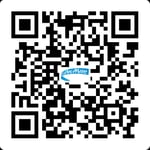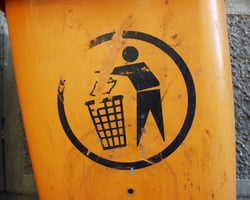Give Back by Clearing Roads of Litter Giving back to your community isn't always an easy task. In...
How to Use QR Codes in Non-Profits
Introduction
 The world has become increasingly digital, and non-profit organizations are no exception. With the rise of smartphones and the widespread use of mobile devices, non-profits have a unique opportunity to engage with their stakeholders in new and innovative ways. Click or Scan the QR Code on the left to watch a video about using QR Codes in non-profit organizations.
The world has become increasingly digital, and non-profit organizations are no exception. With the rise of smartphones and the widespread use of mobile devices, non-profits have a unique opportunity to engage with their stakeholders in new and innovative ways. Click or Scan the QR Code on the left to watch a video about using QR Codes in non-profit organizations.
One tool that has gained popularity in recent years is the QR code, a type of barcode that can be scanned with a smartphone camera to access information or content online.
In this whitepaper, we will explore the various ways in which non-profit organizations can utilize QR codes to enhance their operations, engage with their stakeholders, and achieve their goals. Litter pick-up volunteers contribute their time and effort in the field, not in front of a computer or TV. This whitepaper will explore how QR codes can still make connections and build relationships.
Typical uses of QR codes:
During a June 2021 survey, it was found that 45 percent of responding shoppers from the United States stated they had used a marketing related QR code in the three months leading up to the survey. The share was highest among respondents aged 18 to 29. It was also found that 59 percent of respondents believed that QR codes would be a permanent part of using their mobile phone in the future. In 2022 over 83 million US smartphone users scanned a QR code. QR Codes are the link between an offline user and an online organization. Here are some of the biggest uses:
- Marketing and advertising: Companies use QR codes to promote their products and services by placing them on billboards, posters, business cards, flyers, and other marketing materials. When scanned, the QR code can take the user to a website, social media page, or other digital content.
- Event registration and ticketing: QR codes can be used for event registration and ticketing, allowing attendees to quickly and easily check in or enter the event by scanning a code on their smartphone.
- Product tracking and authentication: QR codes can be used to track products and authenticate their origin or quality. For example, a QR code on a bottle of medicine can be scanned to verify its authenticity and ensure it has not been tampered with.
- Parks use QR codes to show maps, talk more about plants and animals, the historical information about the area, or allow park-goers to report damage and maintenance issues. All this without big, unsightly, and hard to maintain placards.
- Personal identification: Some governments and organizations have started using QR codes for personal identification, such as storing medical records, like COVID-19 vaccinations, or driver's licenses on a smartphone. This allows for easy access to important information and reduces the need for physical documents.
- Payments and transactions: QR codes are used for mobile payments in many countries, especially in Asia. Customers can simply scan the QR code on a merchant's payment terminal or online payment page to complete a transaction.
- Contactless menus and ordering: In the wake of the COVID-19 pandemic, QR codes have become popular for contactless ordering and menu browsing in restaurants and other food and beverage establishments.
Non-profit organizations might use a QR code in these ways:
- To Increase Engagement and Awareness among their stakeholders. By placing QR codes on materials such as flyers, posters, and brochures, non-profits can encourage people to scan the codes and access more information about their cause, mission, and activities. This can help to raise awareness about the organization and its work, as well as engage people in new and meaningful ways.
- Easy Access to Information. QR codes can also provide an easy and convenient way for people to access information about a non-profit organization. By scanning a QR code, people can quickly and easily access specific webpages, social media pages, and other online resources related to the organization. This can help to streamline the process of finding information about the organization, making it easier for people to get involved and support its work.
- Improved Donor Experience QR codes can also be used to improve the experience of donors and supporters. For example, organizations can use QR codes to create a seamless donation process. Printing on event table tents will allow people to make contributions quickly and easily by scanning a code and accessing a donation page.
- Increase connections between the sponsoring organizations and your volunteers -- do more than just displaying their logo. With both a logo and a QR code engagement can be increased with customers and attract new customers by offering promotional offers or social media and newsletter sign-ups.
- Increased Data Collection and Insights. By utilizing QR codes, non-profit organizations can also collect more data and insights about their stakeholders. For example, organizations can use QR codes to track the number of scans and clicks, as well as the location of the people who are scanning the codes. This information can be used to gain a better understanding of the audience and improve the organization's engagement and outreach efforts.
- Event Promotion and Attendance. QR codes can also be used to promote events and increase attendance. For example, organizations can place QR codes on flyers and posters to provide people with easy access to information about the event, such as the date, time, location, and registration process. QR codes can also be used to track attendance at events, allowing organizations to gain insights into their audience and improve future events.
- Volunteer Recruitment and Management. Non-profit organizations can utilize QR codes in the realm of volunteer recruitment and management. QR codes can be used to provide people with easy access to information about volunteer opportunities, as well as to track volunteer hours and activities. For example, organizations can place QR codes on flyers and posters to encourage people to get involved as volunteers, and then use the codes to track their hours and activities. In Keep America Beautiful affiliates, a QR code can direct the volunteer to a form where before and after pictures or videos of a clean-up can be uploaded along with the date, time, and location.
- Campaigns and Advocacy Efforts. In addition to marketing and outreach, non-profit organizations can also use QR codes as part of their campaigns and advocacy efforts. For example, organizations can use QR codes to direct people to online resources where they can learn more about a particular issue (what’s recyclable and what’s not) or campaign, and to encourage them to take action by signing petitions, making donations, or contacting their elected officials.
What is a QR Code
- QR codes are like special barcodes that can be scanned by your smartphone to take you to a website or show you information. They look like a bunch of squares and dots put together, kind of like a secret code!
- When you see a QR code on a poster, brochure, a billboard or even on the TV screen (there were several Super Bowl ads with QR codes), you can use your smartphone camera to scan the code.
- QR code scanners are now a part of almost all smartphone cameras. They automatically detect a QR code and decode it into text or display an internet link to a webpage or form.
There are two types of QR codes:
Static QR Code
- You can’t tell by just looking at the QR code whether it is static or dynamic. You need to scan it to see which it is.
- Static QR code does not need a connection to the internet to work. The dot design is just translated into alphanumeric characters (up to about 4000) and displayed like a text message.
- The text information in the static code cannot be changed after printing – it will always return the same information.
- Static codes cannot provide the creator with any information about when or where the code was scanned.
- Static QR codes can be generated free by any number of apps or online services.
- However, static codes may be useful to display limited information in remote locations where there is no internet connection.
Dynamic QR codes can provide a vast range of information for both the user and the creator:
- When scanned, a dynamic QR code will display a connecting link. When you tap this connecting link, you will be taken to the promised destination on the internet. That destination is most often a webpage, but could be a form, a map, a contact info record, sometimes it’s the app store or payment page.
- For a dynamic QR code to link to these destinations the smartphone will have to be located where there is cell service or a wi-fi and be connected. Otherwise, the link will just be saved in the phone's browser but then can be accessed later when there is an internet connection.
- To create a dynamic QR code a QR Generating Service is required. There are dozens of services available and usually start with limited free version and starter subscription plans for as little as $8/month.
- Besides just creating the code, the service allows the link destination to be changed at any time in the future. This is important since we live in a world of change – the promotional offers, event dates and locations, as well as all kinds of other information are constantly changing.
- In addition to connecting the person scanning to the creator of the QR Code, dynamic codes collect information for the creator. The information collected is the date and time scanned, the number of times it has been scanned, and the locations where it was scanned. See below for other information that can be collected with the scanner’s permission.
Criteria for choosing a QR Code generator service
When selecting a QR code generator service, it's important to consider several criteria to ensure that the service meets your needs and expectations. Here are some of the key factors to consider:
- Customization Options: Look for a service that offers a range of customization options, including the ability to add logos, colors, and designs to your QR codes. This will help you to create codes that are visually appealing and reflect your brand.
- User-Friendliness: The QR code generator service should be user-friendly and easy to use, even for those without technical expertise. It should provide clear instructions and intuitive navigation to ensure that you can create and manage your QR codes with ease.
- Analytics and Tracking: Consider a service that offers robust analytics and tracking capabilities. This will allow you to see how many people are scanning your QR codes, where they are coming from, and what actions they are taking. This information can be valuable in helping you to optimize your QR code strategy and improve your results.
- Integration with Other Tools: Look for a service that integrates well with other tools and platforms you use, such as your website, social media pages, and marketing automation software. This will help you to streamline your workflows and get the most out of your QR code efforts.
- Cost: Consider the cost of the QR code generator service and make sure that it fits within your budget. Some services offer a range of pricing options, from limited use free service to starter plans as low as $8/month on to premium plans, so it's important to find one that meets your needs and budget.
- Reliability and Support: Look for a service that is reliable and provides excellent customer support. This will ensure that you can get help when you need it, and that your QR codes will be up and running when you need them.
Are QR codes safe?
- QR codes are a convenient and versatile way to share information, but like any technology, they come with security risks. To understand the risks just think of a QR code like an email attachment. Even though we encounter QR codes offline the same risks apply. The best protection is simply not to scan or click on anything from a source you don’t yet trust. It is the same with QR codes. Ask yourself:
- Where is the QR code displayed? Is it posted on the property of a trusted organization or professionally printed on brochures or products from a trusted organization?
- Most QR code scams want your money and are placed where you might expect to make a payment. Be wary of payment QR codes that are separated from the service or presented by suspicious persons or use fantastic offer clickbait ploys.
- Like email scams, some QR code scammers will attempt to have you download some malicious software. Be very wary of downloading anything from untrusted sources.
- Data privacy: QR codes cannot capture personal information unless you specifically authorize it. It's important that this information is only shared with trusted parties.
- Misdirection: QR codes can be modified to lead users to different sites or content than intended. This would usually involve a data breach in the creator’s organization. Users should ensure that the code they are scanning matches the content or site they were expecting.
Bottomline:
- Only scan codes in the context of a source you already trust.
- Avoid codes that seem out of place for their purpose.
- Avoid substitute code presented by someone claiming the normal process or code is broken.
- If the “Call to Action” appears too good to be true, it probably isn’t true.
- QR codes make things quick and easy but don’t be rushed – check the source.
QR Code best practices
There’s no point in building out QR codes if your stakeholders can’t (or won’t) scan the codes you develop. Best practices for organizations using QR codes revolve around two main issues: trust and engagement.
Trust: as indicated above, people are advised to scan QR codes only from trusted sources. To increase the trustworthiness of QR codes follow these tips:
- Include your organization’s logo next to or in the center of the QR code.
- Display your QR code in the expected context, for example on the product, in your park, printed in your brochures, posted on a sign on your property.
- Insure the QR code is clearly printed so it scans reliably.
- Have a clear “Call to Action” that clearly describes the benefit of scanning the code. Then ensure the link provides that exact benefit. For example, if a “Call to Action” promises a discount coupon, make sure the QR code directly links to a valid coupon, not a whitepaper, not your homepage.
- It's also important to ensure that any data stored in the code is encrypted and that the code is only shared with trusted parties.
Engagement: Not only must your QR code appear trustworthy, but it needs to invite scanning.
- Make the QR code visually appealing by using colors and shapes. QR codes do not have to be just black and square shaped; there is some flexibility in shape and colors (see the samples above).. However, don’t be so creative that people don’t even recognize it as a QR code. Also, there must be high contrast in the colors used for the dots and spaces.
- Print your QR code large enough so it can be easily scanned from the expected distance. Follow the 10:1 rule. If the scanner’s smartphone would normally be 10 inches from the code, the code should be at least 1 inch square. This would apply to QR codes on products and in brochures. If the QR code is on a banner that would be twenty feet from the user, it should be at least a 24” square.
- Try to make sure your QR code is placed where users are likely to want information and are in a position to scan a code. If you’re marketing a product for runners, it makes sense to place ads on common running routes. But it doesn’t make sense to place QR codes on those running routes, since runners would need to stop their activity to scan a code. Better to include a QR code to your running product at a common post-run watering hole, or in direct mail marketing runners tend to open when they return from a workout. Someone may have a question about a tool (source, user manual, product feedback) so place your QR code related to a tool on the tool itself. Incidentally, scannable QR codes can be printed on t-shirts and safety vests. In short, place your QR code where people are located when they are thinking about a problem or opportunity your content can help solve. Think seasonally or time-sensitively. The QR code link could be changed based on these time/season changes.
- Place where most likely to see and easily scan, like at eye level. Don't make them bend over, reach up, or stretch out dangerously.
- “Call to Action” (CTA) should tell specifically what they will get. It should tip users off on how to engage. For example: "See a Video" "Scan and Win", “Scan for Info”, “Scan to give us Feedback”, “Scan for our Newsletter”, “Scan for Discount Coupon”, “Register Here”, “Upload Photos”, “Get Gift”, “Donate Here”, “Scan for Ingredients”, “Get in Touch”, “See Events”, “Sign Me Up”, “Driving Directions”.
- Instead of just an empty slogan like "We Recycle" QR code could lead to real facts and videos showing what is actually being done
- Make the destination INTERACTIVE - stuff to watch, listen, and respond to. Use video -- conversions increase up to 80% with video. 64% of viewers more likely to buy than with just static pictures and text.
- Ensure the page is "mobile friendly" -- no pdf's please!
- Scatter different codes about and encourage collecting them all to win. Kids, but not many adults, will do this -- it's too much work for little reward.
- Track the data from the scans and make adjustments to improve the number of scans and/or conversions. Use A/B testing of different offers.
- Consider creating personalized QR codes for each prospect, volunteer group, or current/potential sponsors on the mailing list (Bulk QR Codes). Then there is no need for prospect to enter name and other contact already on file. This allows tracking areas where people used the included print coupons most. “In real time, for the first time, they could understand who was actually looking at which coupon in which city and which address,”
Avoid the big mistakes
- Linking to non-mobile friendly destinations
- Long repetitive CTA , especially those that kill the curiosity aspect
- Not providing value to prospects -- offer real discounts and really helpful info
- Poor contrast in QR Code
- Don't display more than one code at a time, avoid confusion and decision paralysis.
- Roadside billboards are questionable since a driver would be dangerously distracted trying to scan the code. Sorry Adopt-A-Highway volunteers.
- Dynamic QR codes won't link where there is no wi-fi or no cell service. Test the QR code’s location or use static QR code.
- Don’t send users to a page that automatically plays media (without letting them know first).
- Not knowing who your target prospect is or not offering something that would interest them specifically.
Conclusion
QR codes offer a wealth of opportunities for non-profit organizations to enhance their operations, engage with their stakeholders, and achieve their goals. From increasing engagement and awareness, to improving the donor experience, to collecting valuable data and insights, QR codes can play a key role in the success of non-profit organizations in the digital age. By utilizing QR codes in a strategic and effective manner, non-profits can make a real difference in their communities and beyond.




